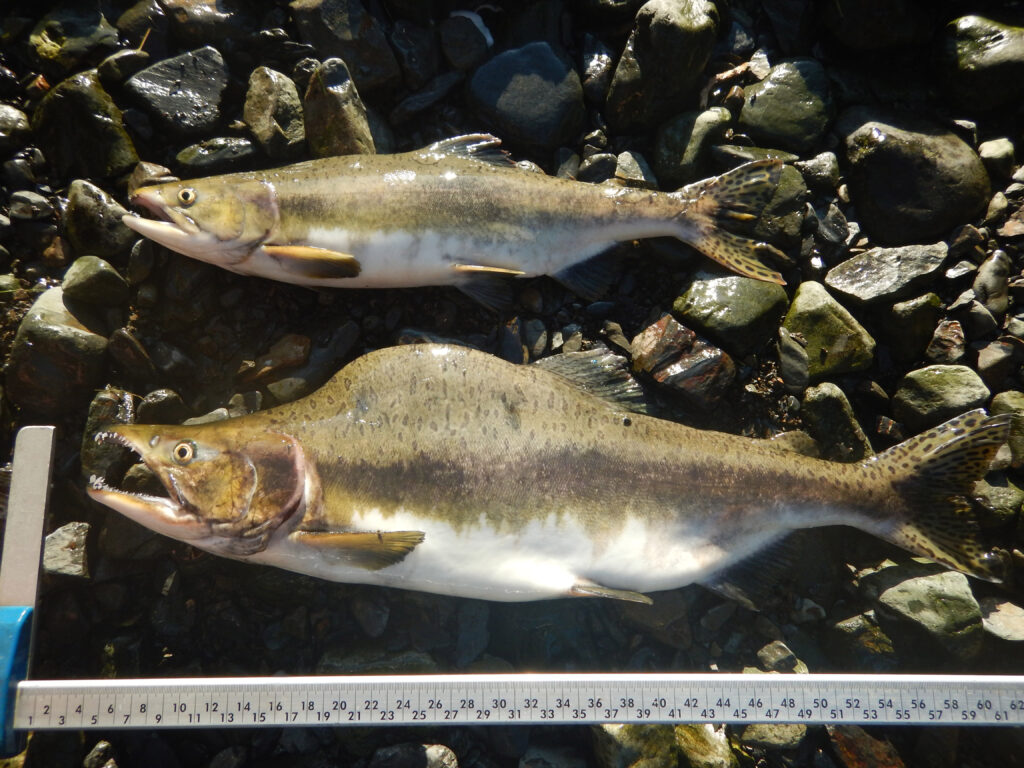
News & Views
Research
Restocking
New study warns of risks of hatchery-raised pink salmon interbreeding with wild populations
July 24, 2024 By Hatchery International staff
 Differences between two male pink salmon highlight morphological diversity in the species. (Photo: Julia McMahon)
Differences between two male pink salmon highlight morphological diversity in the species. (Photo: Julia McMahon) Researchers at the University of Alaska Fairbanks are saying that increasing the population of wild salmon through hatchery programs may reduce diversity among wild salmon.
The number of juvenile salmon released into the North Pacific Ocean by hatcheries is over 5 billion yearly. Salmon hatcheries have increased the annual pink salmon harvests in Prince William Sound, Alaska, from about four million fish to about 50 million in recent years.
Researchers collected data from pink salmon streams in Prince William Sound through the Alaska Hatchery Research Project and found that many hatchery-raised fish are straying onto natural spawning grounds and interbreeding with wild populations.
In a related study, researchers used simulations developed with real-world data to ask what this continued input of hatchery fish might mean for wild populations.
“Even if only a small percentage of hatchery-origin fish stray into wild populations, a small fraction of a huge number can still be a lot,” said Samuel May, lead author of the newly published study in the journal Royal Society Open Science. “We were interested in exploring the long-term consequences of hatchery straying for wild population recruitment and resilience.”
Simulations showed that wild fish population sizes increased because more fish reproduced than would have without hatchery strays. As hatchery-origin gene variants spread into wild populations, diversity among those populations was reduced.
“Wild populations can be very different from one another, but hatchery fish are often more alike. If many individuals with relatively similar traits are introduced into diverse populations, it can make those populations more alike. Lower diversity among populations can reduce resilience to future changes,” said May, who conducted the study as a postdoctoral fellow at UAF’s College of Fisheries and Ocean Sciences.
The simulations used data from an ongoing project in Prince William Sound, which has been collecting tissue samples from hundreds of thousands of pink salmon since 2011. The Alaska Hatchery Research Program has collected samples from 30 streams in the region. This sampling allows researchers to recreate the family trees of pink salmon from five of these sampled streams in the region and determine which fish can be traced back to hatcheries.
May said that it can be difficult to fully capture all the complex relationships in nature. Because the study was specific to pink salmon in Prince William Sound, he said, overarching conclusions about other systems or species should be done with care.
“The same things that make these kinds of models incredibly useful in specific contexts — like their simplifying assumptions and being parameterized with empirical data — also make them misleading if applied in the wrong context,” May said.
Other contributors to the paper included authors from the Alaska Department of Fish and Game and the National Oceanic and Atmospheric Administration.
Print this page
- NOAA recommends $220M for restoration projects
- Canadian Food Inspection Agency confirms MSX disease in PEI oysters





